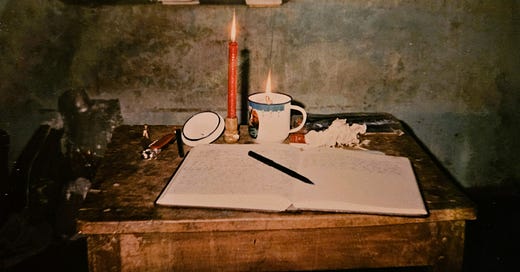At the moment, I’m stuck for an idea for a new story. My often successful techniques to get started—creating an original character, running an exercise in craft, using the storyline from an admired master—ideas that have worked in the past and will again in the future—simply don’t appeal to me at the moment.
Sometimes journals help, though.
Do you keep a journal?
I don’t, though I have from time to time. Large parts of “Babuji” came from the journal I kept in India, and “Babuji” won the Lawrence Prize at Prairie Schooner a lifetime ago. A snippet from my rather anemic Argentina journal got me started on “Evening on the Plaza.” I’m proud of both stories or they wouldn’t appear on this Substack, so I know journals can be a big help.
That being the case, I’m not sure why I don’t keep one more regularly. Maybe doing so depends on one’s temperament or on the rhythm of one’s days. In India, I got up in the morning and, after daily ablutions, meditated, then took a short walk to a restaurant for breakfast. After that I returned to whichever guest house or monastery I was staying in and sat on the roof to write in my journal before going out to seek new adventures—which I would write about the next day. Other times, when the adventures of the day were especially compelling, I wrote by candle light at whatever crude desk the monks had provided my room with.
My life style since then has not been so regular. Sitting beside me right now, unopened for the last month, is one of my India journals. Surely there is something in it that could get me going on a new story. I’m going to break off trying to write today to look through it and then report back if I’ve found something to get me going.
***
Okay, imagine it’s the next day because it really is for me.
Here I am again, having spent part of yesterday’s afternoon wandering through one of my India journals. And guess what, I found something, but I doubt I’ll make fiction of it. An account of a railway trip, it will be a good nonfiction travel piece instead. Interestingly, the central character in this journal entry is the central character of “Jesse James Meets Chairman Mao,” a very different story from what I envision for this nonfiction piece.
Yesterday, as I was getting my car checked over for a long trip I need to take, I wrote an introduction. Here’s what I have so far:
Before I left for my first trip to India, somebody asked me what I could get there that I couldn’t get here in the good old U S of A. I didn’t have an answer to that question, and I still didn’t have one when I came home. But I came home with something else—enough love of the place to want to go back, which I did in 1992. My goal was to go on a Buddhist pilgrimage and write about it, which I did in a short book called Very Bad Buddhist.
Recently, looking over old journals, I came across a rail journey that didn’t make it into the Buddhist manuscript. I’d been staying in a Sakya sect monastery in Lumbini, the place of the Buddha’s birth just over the border in Nepal, and hadn’t had a hot bath in a month. Bathing out of a bucket of cold water loses its charm after about two weeks, so I took a bus down to Varanasi and checked into Clark’s, the best hotel in town at the time. After a couple of days of hot baths and being waited on by uniformed servants in fancifully starched head gear, I bought a ticket to Gaya, where I would visit Bodh Gaya, the place of the Buddha’s enlightenment. In a way, reflecting on that short railway trip has answered the question posed to me all those years ago.
At Varanasi station, I found the first class gari (car) that would drop me off in Gaya before going on from there to Howrah Railway Station in Kolkata (Calcutta at that time). Toting my small and large backpacks, I made my way to a compartment at the end of the car and sat down. Only one other person, a soldier or policeman, I couldn’t tell the difference, was in the compartment and he didn’t seem to speak English.
“Esse first class gari?” I asked on entering and he nodded yes.
It was not an unreasonable question. There is a vast difference between 1st and 2nd class travel on Indian Railways, but sometimes it’s a little difficult for Westerners to tell the difference.
Not a bad start at a first draft. The story goes on from here in the journal. The next step is to type out what’s in the handwritten journal so I can start shaping it.
From time to time, I’ll let you know how that’s going—what I discover and the problems I run into—and possibly post the finished product.
This will be a little exercise in the writing process.
Wish me luck.



